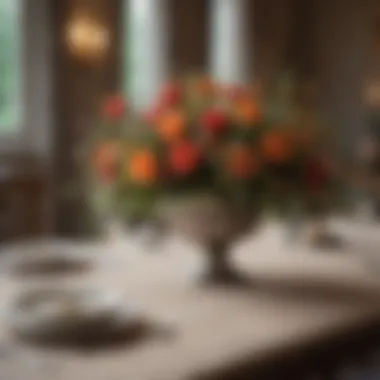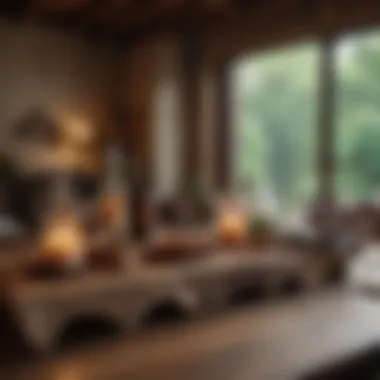Elevating Aesthetics: Table Decorating Inspirations


Intro
Table decorating serves as an essential element in enhancing the ambiance of both dining and living spaces. In today’s world, where aesthetics directly influence experiences, understanding the nuances of table decor becomes paramount. This guide aims to delve into various themes, materials, and seasonal inspirations that allow individuals to elevate their table settings with sophistication and style.
A well-decorated table does not merely serve a functional purpose but also creates visual appeal and invites conversation. Whether for casual gatherings or formal events, the approach to table decor can greatly impact the atmosphere. This article is tailored to those discerning individuals who seek to integrate elegance into their settings, ensuring that each table arrangement reflects personal taste and complements the occasion.
By exploring the myriad of options available, from outdoor decor to exclusive destinations, readers are equipped to create settings that are not only visually appealing but also deeply meaningful. They are encouraged to consider various aspects, including seasonal influences and sustainable practices. The importance of thoughtful design cannot be overstated in the current aesthetic landscape, where every detail contributes to the overall experience.
Understanding Table Decorating Fundamentals
Table decorating is an art that bridges creativity and functionality. It is more than just placing items on a table; it requires an understanding of various elements that can enhance the overall dining experience. The fundamentals of table decor such as choosing the right table linens, centerpieces, and tableware can significantly influence the atmosphere and aesthetic appeal of the setting.
The Importance of Table Decor
Table decor serves as the foundation for any dining or gathering situation. It defines the mood and invokes a sense of welcome for guests. An appealing table setting can elevate a simple meal into a memorable occasion. The decor should reflect the purpose of the gathering, whether formal, casual, festive, or intimate. The right table setting can set expectations and enhance the enjoyment of the event.
Moreover, a well-decorated table contributes to the overall ambiance of the space. Consideration of colors, textures, and themes can create visual harmony with the surrounding decor. In essence, table decor acts not just as a backdrop but as an integral part of the overall experience.
Key Elements of Table Design
Understanding the key elements of table design is crucial for effective table decorating. Each component plays a vital role in creating a cohesive look that aligns with your desired aesthetic.
Table Linens
Table linens are more than merely functional; they add depth and texture to the table setting. High-quality fabrics such as linen or cotton can introduce a touch of elegance and warmth. They come in various colors and patterns, allowing for personalization to match the occasion.
A unique feature of table linens is their ability to define the space. For instance, a crisp white tablecloth can lend a formal feel, while a colorful runner can make the table pop. However, poor fabric choices can detract from the overall design or create a cluttered appearance. Therefore, selecting appropriate linens plays a pivotal role in achieving the desired aesthetic.
Centerpieces
Centerpieces act as focal points in table design and are pivotal in enhancing visual interest. They can range from simple floral arrangements to elaborate decorative displays. The key characteristic of a centerpiece is its ability to draw attention while complementing the overall aesthetics of the table.
A well-chosen centerpiece can enhance the theme of the gathering without overwhelming other elements. However, overly tall centerpieces may obstruct conversation among guests, thus it is important to consider height and scale. Effective centerpieces help in establishing a refined focal area while maintaining the table's functionality.
Tableware
Tableware encompasses all dishes, glasses, and utensils used during a meal. The choice of tableware can reflect both a theme and personal taste. Porcelain is often preferred for formal settings due to its finish and durability. Stoneware, on the other hand, provides a more casual, rustic feel, which is popular for informal occasions.
The unique feature of tableware is its variety; each piece has a distinct style that contributes to the overall setting. Selecting the right tableware can create an inviting atmosphere. However, an uncoordinated set may lead to visual chaos. Therefore, consistent choice in design and color is critical to maintaining a balanced and elegant table setting.
Themes in Table Decorating
Themes in table decorating serve as a framework to create visually cohesive and emotionally resonant settings. They allow individuals to curtail their creativity while focusing on a specific atmosphere or concept. When you select a theme, you effectively guide your choices regarding colors, materials, and accessories. This connection makes your table setting not just a feast for the eyes but a meaningful experience for guests. Moreover, themes reflect the host's taste, personality, and the occasion, enhancing the overall impact of the event.
Seasonal Themes
Seasonal themes provide a fresh perspective on table decoration, aligning with nature's cycles. Each season carries its distinct character, offering unique inspirations. By tapping into these seasonal motifs, you can enrich your table setting with vibrant colors and relevant elements. Here are some specific explorations of seasonal themes:
Spring Inspirations
Spring is characterized by renewal and vibrancy. Incorporating floral designs and pastel colors are hallmark features in spring table decor. This approach not only symbolizes growth but also invigorates spaces with a sense of life. Using tulips, daffodils, or cherry blossoms can bring a fresh air. A disadvantage could be the ephemeral nature of fresh flowers; they may require more upkeep. Nevertheless, the atmosphere created is generally one of cheerfulness and rejuvenation, making spring a sought-after theme.
Summer Elegance
Summer elegance emphasizes bright colors and bold patterns. This theme often showcases the bounty of the season with fruit motifs and airy linens. Bright yellows, blues, and greens capture the essence of sunny days, creating a lively atmosphere. A unique feature of summer elegance is the use of outdoor elements, like seashells or rustic wood, making it popular for al fresco dining. The main disadvantage might be the risk of overdoing brightness, leading to a cluttered look. Still, when balanced well, the result is both inviting and refreshing.
Autumn Warmth
Autumn warmth enriches tables with earthy tones like burnt orange, deep red, and golden yellow that reflect the season's colors. Centerpieces made from leaves, gourds, and seasonal fruits add a unique touch. The key characteristic of this theme is its ability to evoke a sense of coziness and comfort. It is particularly beneficial for harvest celebrations and Thanksgiving events. However, the emphasis on rustic elements might not suit more formal occasions, which is a consideration to bear in mind.
Winter Whimsy
Winter whimsy contrasts light and dark through rich textures and seasonal imagery. This theme often includes elements like snowflakes, evergreens, and candlelight, creating a magical environment. The use of cooler color palettes and sparkly accents bring in a holiday spirit. One unique feature is the incorporation of unexpected decor pieces, such as vintage ornaments. However, the reliance on certain motifs like snowflakes might limit creativity if not accompanied by broader designs. Overall, winter whimsy generates a festive mood that many appreciate during the cooler months.
Cultural Influences
Cultural influences in table setting underscore the vast array of aesthetics derived from different traditions. Understanding these approaches can enhance your decorations and provide depth to the dining experience. They allow one to embrace global influences, making the table setting a canvas for storytelling.
Traditional Approaches
Traditional approaches provide a link to history and heritage. Often marked by fine china and elegant flatware, these settings exude sophistication and respect for time-honored customs. The key characteristic lies in using established materials and patterns, reflecting cultural norms. This approach integrates widely recognized motifs. It is a beneficial choice for formal events and gatherings, establishing a sense of elegance. Each piece often carries cultural significance. However, it may limit creativity, as traditional designs can be somewhat rigid in interpretation.


Modern Flair
Modern flair introduces innovation and freshness to table decorating. It prioritizes minimalism, bold colors, and unusual materials, creating a striking contrast to traditional designs. The main advantage is the freedom of expression it offers, allowing hosts to experiment without confines. Unique features include geometric patterns and asymmetrical designs, breaking boundaries in table aesthetics. The downside could be the potential for overly stark arrangements, which may not feel warm or inviting. Nevertheless, modern flair is popular among those looking to push the envelope in hospitality.
Materials that Define Luxury
The selection of materials plays a crucial role in defining the aesthetics of any table setting. Luxury is synonymous with quality, and the right materials can significantly enhance the overall appeal of your decor. These materials not only serve a functional purpose but also convey a sense of elegance and sophistication. A carefully curated selection of table materials can elevate an ordinary dining experience into a memorable occasion. In this section, we will delve into key components such as table linens, tableware, and natural elements that collectively enhance luxury in table decorating.
Choosing Quality Table Linens
Fabrics and Textures
When it comes to table linens, the choice of fabric and texture is critical. High-quality materials like linen, silk, and satin are often used. These provide a luxurious feel and durability. Linen, for instance, offers a natural elegance while also being easy to care for. The tactile experience of these fabrics adds depth to the aesthetic. Additionally, texture can create visual interest. A table with layered linens, where fabric has different textures, becomes more intriguing.
Despite the high cost attached to premium fabrics, their longevity often justifies the initial investment. However, one must also be aware that some materials may require more delicate care and may not be suitable for all occasions.
Color Schemes
Color plays a vital role in table decorating. When selecting table linens, the color scheme should harmonize with the overall theme. Neutral tones often evoke elegance, while vibrant hues can create a lively atmosphere. A well-chosen palette not only complements the food but also enhances the visual experience.
Using bold colors can make a statement. However, it is essential to balance them with subtler shades to avoid overwhelming the setting. The unique feature of color schemes lies in their ability to transform a space significantly, making them a key aspect of luxury table decorating.
Selecting Tableware
Porcelain vs. Stoneware
Tableware options like porcelain and stoneware have distinct characteristics. Porcelain, known for its fine quality, often features intricate designs. It is more delicate yet elegant. Stoneware, on the other hand, is robust and ideal for everyday use. Its earthy feel lends a rustic charm, making it suitable for various occasions.
The choice between the two relies on the intended atmosphere. Porcelain is ideal for formal settings, while stoneware works well for casual gatherings. Each material has its pros and cons, such as the need for careful handling of porcelain, compared to the durability of stoneware.
Glassware Varieties
Various glassware types contribute significantly to table decor. Crystal glassware is synonymous with luxury, reflecting light beautifully. On the other hand, hand-blown glass can offer a unique artistic touch due to its bespoke nature. The clarity and design of glassware can elevate the overall table setting.
Moreover, selecting appropriate glassware for various beverages is essential. For example, wine glasses should be designed to enhance the flavor of the wine served. The challenge is ensuring the glassware complements other elements without overpowering them. Thoughtful selection here can create a cohesive and visually stunning table.
Incorporating Natural Elements
Floral Arrangements
Floral arrangements add a touch of nature, breathing life into the decor. They can range from elegant bouquets to simple centerpieces. The choice of flowers influences the ambiance, with fresh flowers often creating a more uplifting atmosphere. Seasonal flowers can also tie into themes, making the setting feel more cohesive.
However, fresh flowers require maintenance and may not last long after the event. Selecting long-lasting alternatives or dried flowers can alleviate these concerns, while still adding beauty.
Organic Decor
Incorporating organic decor elements, such as fruits, branches, or greenery, can add a refreshing spruce to the table. These items often bring texture and color, enhancing the overall aesthetic appeal. They create an effortless yet sophisticated vibe.
The simplicity of employing organic materials often resonates well with guests, reflecting a more grounded approach to luxury. However, considerations regarding freshness and upkeep are necessary to maintain the intended look. Ultimately, natural elements should complement the existing decor without detracting from its elegance.
Choosing the right materials sets the foundation for any successful table decor. Quality linens, distinctive tableware, and thoughtful natural elements work together, enhancing the overall dining experience.
Practical Considerations in Table Decorating
When it comes to table decorating, there are several practical considerations to keep in mind. These factors ensure that your design is not only visually appealing but also functional for the specific setting. The interplay between aesthetics and functionality can significantly shape the dining experience, impacting both the enjoyment of the meal and the overall atmosphere of the gathering. By addressing these practical aspects, one can create a table setting that balances beauty and usability.
Maintaining Functionality
Balancing Aesthetics and Use
Balancing aesthetics and use is vital for any table setting. This concept refers to the ability to create a visually pleasing arrangement without sacrificing practicality. A well-designed table not only attracts the eye but also accommodates the needs of the guests. This balance helps maintain an inviting environment. It is important to choose decorations that simply complement the dining experience.
When considering this, it is crucial to select items that do not obstruct movement or hinder conversation. For example, low but attractive centerpieces are often selected to ensure visibility across the table. Height can be an important factor in making items blend well while still keeping surfaces usable.
Space Management
Space management is another important consideration. This involves the strategic arrangement of table elements to maximize function and comfort. Cluttered tables may overwhelm guests or hinder their interactions. Therefore, maintaining adequate space between items encourages ease of movement.
An effective layout allows guests to reach food and drinks without trouble. Using plates or dishes that are appropriately sized can help in managing space. For larger gatherings, consider grouping items into designated areas to organize the table more effectively while also promoting a quality aesthetic.
Budgeting for Elegance
Budgeting for elegance is often a crucial element of table decorating. This involves finding ways to create sophisticated settings without overspending. By understanding how to source materials effectively, you can achieve upscale looks at reasonable prices.


Smart Sourcing
Smart sourcing refers to the practice of locating high-quality items at reasonable costs. This process can involve researching local markets, visiting thrift stores, or even shopping online. Each of these avenues can yield unique and beautiful pieces that enhance your decor without breaking the bank.
Incorporating vintage tableware or handmade items can add charm and individuality. Not only does this reduce costs, but it also supports smaller artisans or local shops. Balancing quality with affordability enriches the overall experience.
DIY vs. Professional Services
DIY versus professional services is a common dilemma for many decorators. Each approach to table decorating has its own merits. DIY allows for full creative control and can be cost-effective if you are skilled and have the time. It fosters a personal touch that can be quite meaningful in special settings where guests appreciate the effort.
On the other hand, hiring professionals offers a level of expertise that ensures quality and cohesion in the decor. Professionals can often produce results more efficiently. The investment in their service could also save time and reduce stress.
When deciding between these options, consider both your budget and the level of expertise required. Balance your desire for elegance with the practicality of implementation.
Elevating Occasional Settings
Elevating occasional settings is crucial in table decorating. It shapes the experience for guests and enhances the ambiance of the gathering. A well-decorated table does more than serve food; it creates a mood and sets the tone for conversations. Through thoughtful arrangements and stylish details, one can transform a regular meal into a memorable event.
Formal Gatherings
Creating an Intimate Atmosphere
Creating an intimate atmosphere is essential for formal gatherings. This setting fosters connection among guests, allowing for deeper interactions. Soft lighting, delicate table linens, and elegant tableware all contribute to this ambiance. The key characteristic of an intimate atmosphere is its ability to make everyone feel comfortable and welcomed. This is often considered a popular choice in high-end dining experiences.
A unique feature of this atmosphere is the usage of low centerpieces. They ensure clear sight lines across the table, enhancing conversation. However, it is important to maintain balance. Too many decorations can clutter the space and distract from the meal. Therefore, less is often more.
Choosing Appropriate Accessories
Choosing appropriate accessories plays a significant role in formal settings. The right details can elevate the aesthetic and refine the overall tablescape. Elegant napkin rings, sophisticated place cards, and stylish chargers are a few key accessories that enhance the table setting. They turn an ordinary table into an extraordinary one, reflecting sophistication and care.
The unique feature of appropriate accessories is how they can tie together the theme of the gathering. A cohesive look, achieved through color coordination and material selection, can leave a lasting impression. However, selecting too many mismatched accessories can detract from the aesthetic and create confusion. Therefore, simplicity and coherence should guide the selection process.
Casual Settings
Inviting Warmth and Comfort
Inviting warmth and comfort is fundamental in casual table settings. This approach transforms the atmosphere into a relaxed space where guests can enjoy each other's company. Elements such as soft fabrics, comfortable seating, and casual tableware contribute significantly to this setting. The key characteristic of warmth in decor is its ability to make guests feel at home.
A unique feature of this setting is how personal touches, like family heirlooms or handmade items, can create a welcoming vibe. Such elements invite stories and memories, enriching the dining experience. However, it is essential to maintain a balance. Too much clutter can make the table feel cramped and chaotic.
Utilizing Everyday Items
Utilizing everyday items can greatly enhance casual settings. This approach demonstrates creativity while remaining functional. Familiar items can mean using favorite dishes or simple glassware, allowing for an effortless but stylish table setting. The key characteristic of this choice is its accessibility, making it a practical option for everyday gatherings.
What sets this approach apart is how it emphasizes personalization. Everyday items often carry sentimental value, making the gathering feel intimate. However, over-reliance on casual items can lead to a lack of polish. Therefore, blending everyday items with one or two elegant pieces can strike the right balance and maintain visual interest without sacrificing comfort.
The Role of Lighting in Table Decor
Lighting plays a crucial role in table decorating, influencing the overall atmosphere and aesthetics of a dining experience. It can transform a simple table setting into something extraordinary. Effective lighting not only highlights the elements of decor but also sets the mood for the gathering. Table lighting needs careful consideration, as it can enhance or detract from the dining experience. It is essential to match the type and brightness of lighting to the occasion and the theme of the decor.
Types of Lighting
Candlelight Elegance
Candlelight creates a warm and inviting glow that is hard to replicate with other light sources. This type of lighting is known for its soft flicker and gentle illumination, making it a popular choice for creating cozy and intimate settings. Candles can vary in height, shape, and fragrance, allowing flexibility in design. The natural dimness of candlelight adds an air of sophistication and romance, ideal for formal dinners or quiet evenings.
However, one must be cautious with candle placement. They should be positioned safely away from flammable items. While they create ambiance, candles may also limit visibility for some diners. Therefore, combining candlelight with other lighting forms can work better.
Ambient Lighting Options
Ambient lighting includes overhead chandeliers, wall sconces, and recessed lights that provide overall illumination. This type of lighting is essential for visibility and can enhance the elegance of the table by highlighting decor without being overwhelming. It is usually softer and broader than task lighting, allowing guests to enjoy their meals comfortably.
One key characteristic of ambient lighting is versatility. It can be adjusted in brightness, which is beneficial for different occasions. For example, softer settings work well for family dinners while brighter settings suit more festive gatherings. The right balance is important, as too bright can feel harsh while too dim can make it hard to engage with the dining experience.
Creating Mood Through Light
In any table setting, light can evoke various emotions and responses. From the intimate whisper of candlelight to the cheerful brightness of a festively lit space, understanding how lighting influences mood is essential.
To create the desired atmosphere:
- Use dimmers to control brightness.
- Incorporate color in lighting, such as warm hues for cozy settings.
- Strategically place lights to accentuate key design elements.


With careful thought, lighting becomes not just a practical necessity but an integral part of the decor, enhancing the overall dining experience.
Innovative Techniques in Table Decorating
Innovative techniques in table decorating are essential for transforming a simple dining experience into a memorable occasion. These methods introduce unique aesthetics that go beyond traditional styles, offering a fresh perspective on how a table can be adorned. When executed thoughtfully, innovative techniques not only enhance the look of a setting but also contribute to the overall ambiance of an event or gathering.
By focusing on techniques such as layering textures and applying color theory, one can create depth and personality in table decoration. The advantages are multifold: it captivates the eye, instills a sense of elegance, and invites diners into an artistry of experiences. The careful selection of materials in layering can elicit various themes and moods, while color theory helps in harmonizing visuals, ensuring cohesion in the entire setup. This section will delve into two innovative techniques: layering textures and using color theory.
Layering Textures
Layering textures is a technique that can transform a table from ordinary to extraordinary. By combining different materials—such as table linens, glassware, and centerpieces—designers can achieve rich visual interest. For example, pairing a soft linen tablecloth with a burlap runner can create a beautiful contrast, allowing both textures to stand out.
Consider utilizing items such as ceramic dishes alongside polished silverware. The tactile differences add dimension, encouraging guests to appreciate both the aesthetic and the physical experience.
Benefits of Layering Textures:
- Visual Depth: Different textures add complexity.
- Enhanced Experience: Tactile engagement makes dining more enjoyable.
- Thematic Cohesion: Textures can reflect the theme of the event.
Choosing the right combination calls for thoughtful selection. Opt for complementary materials that relate to the theme and occasion. Test combinations with samples before the final setup. This practical approach ensures that the textures work well together.
Using Color Theory
Color theory is a critical component of table decorating that can significantly impact the perception of a dining space. Understanding how different colors interact can help in crafting a visually appealing layout. For instance, cool colors like blues and greens tend to create a calm atmosphere, while warm colors such as reds and yellows elicit energy and excitement.
One effective method is to use a 60-30-10 rule for color distribution: 60% for the main color, 30% for the secondary color, and 10% for an accent color. This systematic approach yields a balanced and aesthetically pleasing arrangement.
Key Considerations When Applying Color Theory:
- Choose a Color Palette: Settle on a foundational palette before selecting specific items.
- Seasonal Adaptation: Modify colors based on seasonal events for relevance.
- Balance Warm and Cool Tones: Achieve harmony by blending these tones thoughtfully.
Overall, layering textures and using color theory are significant aspects of table decorating. When refined techniques are employed, they serve not just to elevate the design but also to enhance the dining experience as a whole.
Sustainable Approaches to Decor
Sustainable approaches to decor have gained significant importance in recent years, especially in the context of table decorating. The certainty that our environmental footprint impacts not just our lives today but also future generations is prompting a shift towards eco-conscious choices in aesthetics. With resources depleting and environmental concerns rising, it becomes crucial to integrate sustainability into the design of our dining spaces. Not only does this reflect a sense of responsibility, but it also offers unique opportunities for creativity and innovation in table decor.
By prioritizing eco-friendly materials and reducing waste, individuals can achieve elegant table settings while contributing positively to the environment. Sustainable practices encourage the use of locally sourced items or items with minimal environmental impact, creating a distinct and personalized aesthetic. This also allows for a connection between the decor and the natural world, which can enhance the overall dining experience.
Eco-Friendly Materials
In the realm of sustainable table decorating, eco-friendly materials play a pivotal role. Choosing items that are sustainably sourced or made from recycled products can help minimize environmental impact. Here are some materials to consider:
- Bamboo: This fast-growing plant is not only strong and durable, but it also is biodegradable, making it an excellent choice for tableware, utensils, or decorative accents.
- Recycled Glass: Items made from recycled glass can add a unique touch to your table decor. They are available in many styles and colors, providing versatility with a reduced carbon footprint.
- Organic Cotton: For linens, organic cotton avoids harmful chemicals used in conventional cotton farming, resulting in a safer option for your home and the environment.
- Natural Fibers: Materials like linen, jute, or hemp add texture and comfort to table settings, all while being eco-friendly choices.
Incorporating these materials not only elevates the aesthetic appeal of the table but also promotes a responsible approach to consumerism that is increasingly appealing to a discerning audience.
Reducing Waste
Reducing waste is another critical aspect of sustainable table decorating. This means adopting practices that minimize discarded products and promote longevity and reuse. Key strategies include:
- Multi-Purpose Decor: Use items that can serve multiple purposes. For instance, elegant glass containers can be used for both food presentation and as a centerpiece.
- Investing in Quality: Opt for durable, high-quality tableware that can withstand time and trends, thus decreasing the need for frequent replacements.
- DIY Projects: Consider creating your own decor pieces. This not only reduces waste but also lends a personal touch to your table settings with items such as handmade place cards or centerpieces crafted from upcycled materials.
- Composting: For biodegradable table items or food remnants, integrating a compost system can significantly reduce waste output while enriching garden soil regarding nutrients.
Sustainable table decorating is not just about aesthetics; it reflects a lifestyle choice that prioritizes health and environmental responsibility.
By understanding the principles of eco-friendly materials and implementing strategies to reduce waste, individuals moving toward sustainable practices will find satisfaction in both the beauty of their dining spaces and the positive impact on the planet.
Final Thoughts on Table Decorating
The art of table decorating is a reflection of one's personal taste and an extension of hospitality. It transcends mere function, merging aesthetics with intention. In finalize our journey through various aspects of table decor, it is crucial to emphasize several essential elements, benefits, and considerations that enhance the overall experience for both hosts and guests.
When it comes to table setting, the personal touch cannot be overlooked. Individual style plays a significant role in making a dining space unique and memorable. The choices made during the decorating process serve not only to beautify the table but also to express the host's personality and values. Understanding these elements and integrating them into one’s decor increases the likelihood of creating a favorable atmosphere.
The Personal Touch
Reflecting Individual Style
The concept of reflecting individual style within table decorating is an exercise in authenticity. This personal expression adds depth to the overall decor and cultivates a sense of belonging for guests. One of the key characteristics of this approach is the thoughtful selection of items that resonate with the host’s identity. Choosing colors, patterns, and designs that align with personal tastes results in a cohesive and inviting aesthetic.
The primary benefit of prioritizing individual style is that it sets a tone for accessibility and warmth during gatherings, making guests feel more at ease. A unique table setting invites guests into the host's world, creating an intimate experience. However, it is important to balance personal flair with practicality. An overly eclectic approach may risk overwhelming guests or detracting from the central theme of the event.
Creating Lasting Memories
Creating lasting memories is a pivotal aspect of table decorating. This dimension focuses on the overall experience that a beautifully set table can facilitate. A key characteristic of this focus is its ability to evoke emotions, whether through enticing aromas, stimulating conversation, or visually appealing surroundings. The unique feature of a well-designed table setting is its capacity to transform a simple meal into an unforgettable event.
The advantages of having a memory-centric table setup include the ability to foster stronger connections. Engaging guests emotionally leads to more profound interactions and shared moments. However, this approach requires meticulous planning; failure to deliver a cohesive experience can result in underwhelming impressions. Therefore, careful consideration of each detail is crucial to ensure that the memories created are positive and long-lasting.
“A well-set table is a painter’s canvas for nourishing thought and camaraderie.”
By focusing on these essential components, individuals can craft a table setting that is not just visually appealing but truly memorable.







